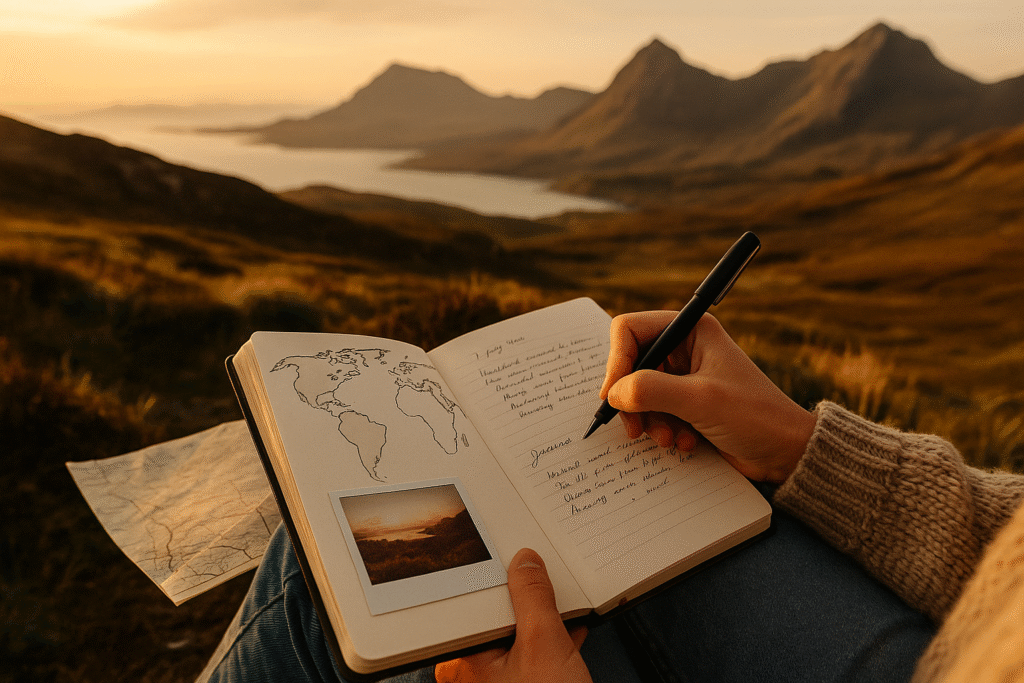Travel journaling is more than just an activity; it’s a powerful way to capture the essence of your travels, reflect on your experiences, and plan for future adventures. Whether you’re an experienced traveler or embarking on your first long-term trip, journaling can serve as a practical tool for organizing, reflecting, and enhancing your travel experience. But what is the best way to journal a trip, and how can you use journaling for long-term travel planning? In this article, we’ll explore the many benefits of travel journaling, provide tips on how to make the most of your travel journal, and show you how to use journaling as an effective tool for long-term travel planning.
Why Journal a Trip for Long-Term Travel Planning?
Preserve Precious Memories
When you’re traveling for an extended period, the best way to journal a trip is by capturing the fleeting moments that might otherwise fade from memory. Travel journaling serves as an invaluable record of your adventures. With each entry, you’re not only capturing the places you’ve visited but also the emotions, sensations, and experiences you encountered along the way. While photographs can capture an image, journaling allows you to paint a richer, more nuanced picture of your travels. It’s the difference between looking at a photo and reading about the thoughts and feelings you had when the picture was taken.
Foster Personal Reflection
Journaling has long been recognized for its therapeutic benefits. For travelers, it provides a space for emotional reflection and mindfulness. Writing about your journey can help process challenging experiences, calm anxieties, and provide clarity in moments of uncertainty. This type of reflection can be especially helpful when you’re on a long-term trip, where you might encounter both highs and lows. So, in addition to the best way to journal a trip being about planning, it’s also about emotional processing.
Plan and Organize Your Travel
Journaling isn’t just about reflection; it’s also a practical tool for long-term travel planning. A well-maintained journal can serve as your go-to guide for organizing your thoughts, budgets, itineraries, and even packing lists. By planning your next steps through journaling, you’re able to stay focused on your goals and create a roadmap for your adventures. Whether you’re figuring out how to spend the next month or outlining a year of travel, the best way to journal a trip is to integrate these practical aspects with your experiences.
In the following sections, we’ll explore how to use your travel journal to plan your next trip while also preserving the magic of the one you’re currently experiencing.
Tools and Techniques for Effective Travel Journaling
Choosing the Right Journal
Before diving into travel journaling, it’s important to select the right tools. In today’s digital age, you may wonder whether it’s better to use a physical journal or a digital platform. Both options have their pros and cons, so let’s break them down:
Traditional Paper Journals
For many travelers, there’s something special about putting pen to paper. Paper journals have a tactile quality that digital devices simply can’t replicate. They also allow for greater creativity whether you’re sketching, pasting in tickets and postcards, or even making handwritten notes.
- Pros: Tangibility, creativity, personal connection.
- Cons: Can be bulky and heavy to carry.
Digital Journals and Apps
On the other hand, digital journals and apps (such as Polarsteps or Journey) offer a convenient and organized way to document your travels. They allow you to store photos, make entries on the go, and sync your journal across multiple devices.
- Pros: Accessibility, convenience, multimedia integration.
- Cons: Less personal than writing by hand.
When deciding between the two, consider your travel style. If you prefer a more hands-on approach and like to collect mementos, a traditional journal may be best. If convenience and portability are important, a digital journal may suit your needs better.
Incorporating Visuals into Your Journal
One of the most rewarding aspects of journaling is the ability to incorporate visuals. Photographs, drawings, and even maps can complement your written entries and provide a richer, more immersive travel experience. Consider including:
- Photos: Attach or print your favorite photos alongside your journal entries. This helps capture moments that words alone may fail to describe.
- Sketches and Drawings: Even if you’re not an artist, sketches can bring life to your journal. Try sketching a landscape, your favorite street food, or even a scene from a local market.
- Maps: Including maps or sketches of your route is a great way to visualize your travels and track your journey.
According to Psychology Today, incorporating visuals into journaling can greatly improve memory retention and emotional connection. For more about how creative expression through journaling can boost well-being, read this insightful article on the benefits of visual journaling.
Utilizing Prompts for Daily Entries
If you’re unsure where to start or what to write about, travel journal prompts can spark inspiration. Here are some ideas to get you going:
- Where did you go today?
- What was your most memorable experience of the day?
- Who did you meet, and what did you learn from them?
- What surprised you today?
- What local foods or customs did you encounter?
Incorporating prompts like these ensures that you don’t miss any important details and helps you focus on meaningful experiences.
Structuring Your Travel Journal for Long-Term Planning
Effective travel journaling goes beyond simply writing down thoughts and experiences; it also serves as a tool for planning future trips and keeping your travel goals on track. The best way to journal a trip for long-term planning is to create sections in your journal that help you stay organized, focused, and prepared for what’s ahead.
Pre-Trip Entries
Before your trip, your journal can help you lay the groundwork for a successful journey. This section is ideal for:
- Destination Research: Research the countries or cities you plan to visit, jot down must-see places, and outline any logistical details such as visa requirements and safety tips.
- Packing Lists: Keep a list of essential items you’ll need for your trip, and update it as you discover more things to bring.
- Budget Planning: Outline a travel budget that includes flight costs, accommodations, food, and entertainment expenses. Use your journal to track your spending while on the road.
Daily Logs
Once you’re on the road, your journal becomes a daily log for experiences and reflections. In addition to the obvious details (where you went, what you did), consider adding:
- Expenses: Keep track of daily expenses so you can stay within your budget.
- Itinerary Adjustments: If plans change or you decide to add new destinations, update your journal accordingly.
- Personal Growth: Reflect on how the journey is affecting you emotionally and mentally. How are you changing as a person?
Post-Trip Reviews
Once your trip is over, don’t just close the book. Use your journal to look back and assess your travel experience. Include:
- Lessons Learned: What worked well? What would you do differently next time?
- Future Travel Goals: After reflecting on your current journey, what destinations do you want to visit next? What did you learn about your travel preferences?
- Memories: Include a section dedicated to your favorite memories, such as funny stories or encounters with new friends.
The Best Way to Journal a Trip for Future Adventures
One of the best ways to journal a trip is to make sure you use your travel journal for future planning, not just documenting past experiences. Consider dedicating a section of your journal specifically for mapping out your next journey. Here’s how you can use your journal to plan for future trips:
Setting Long-Term Travel Goals
Before embarking on your next adventure, set clear, achievable goals. Use your journal to write down places you’d like to visit, experiences you want to have, and activities you want to try. Reflecting on what you want out of your travels will help you prioritize where to go and what to do.
Research and Inspiration
Use your journal to compile research, such as must-visit destinations, recommended activities, and tips from fellow travelers. This can be your go-to resource for future travel ideas and inspiration.
Vision Board for Travel
Many travelers find it helpful to create a vision board in their journal. This can include pictures, quotes, and notes that inspire your future travels. A vision board helps keep your travel dreams alive and motivates you to continue planning for your next trip.
The Psychological and Practical Benefits of Journaling
Mental Well-Being
Journaling can have a profound impact on your mental health, particularly when it comes to stress reduction and emotional processing. Writing about your daily experiences, frustrations, or challenges can help release negative emotions and clear your mind. Journaling also fosters mindfulness, which can enhance your overall travel experience by helping you stay present in the moment.
Studies have shown that journaling can reduce anxiety and improve self-awareness, making it a powerful tool for mental well-being during long-term travel. It’s part of the best way to journal a trip that supports both your emotional and practical needs. For further insight, read about the mental health benefits of journaling in this Psychology Today article.
Enhanced Memory Retention
When you write about your experiences, you reinforce your memories. Studies indicate that the act of writing improves memory retention, allowing you to recall even the smallest details of your journey long after you’ve returned home. Your travel journal thus serves as a personalized record, ensuring that your memories remain vivid.
Goal Achievement
Travel journaling is also an excellent tool for setting and tracking travel-related goals. Whether you want to visit a specific number of countries, try new activities, or immerse yourself in different cultures, your journal can help you outline and achieve these goals. By regularly reviewing your journal, you stay motivated and focused on the bigger picture. This method is one of the best ways to journal a trip, especially for long-term travelers.
Real-Life Examples and Success Stories
Case Study: Sarah’s 6-Month Backpacking Journey
Sarah, a solo traveler from Australia, used journaling as a way to track her experiences and plan her upcoming destinations. During her six-month backpacking trip across Southeast Asia, Sarah’s journal became a key resource for organizing her budget, booking accommodations, and setting travel goals. By the end of her journey, she had an extensive record of her adventure, complete with photographs, personal reflections, and plans for her next trip to Europe.
Expert Insight: The Power of Journaling for Long-Term Travel Planning
Many travel bloggers and seasoned travelers swear by the benefits of journaling. In fact, famous travel bloggers like Nomadic Matt and The Blonde Abroad recommend journaling as a way to keep track of both memories and practical travel details. Their journals help them stay organized and reflect on their experiences in a meaningful way.
Conclusion: Embrace the Power of Travel Journaling
The best way to journal a trip is not just about documenting what happens, it’s about reflecting on your experiences, organizing your thoughts, and using journaling as a tool for long-term travel planning. Whether you’re using a digital app or a traditional notebook, your journal will become an invaluable resource that helps you stay focused on your goals, process your emotions, and create lasting memories.
Start Journaling Today: Plan Your Next Adventure
Ready to start journaling your own adventure? Use the best way to journal a trip to document your experiences, plan your next journey, and set your travel goals. Share your favorite travel journaling tips in the comments below!







